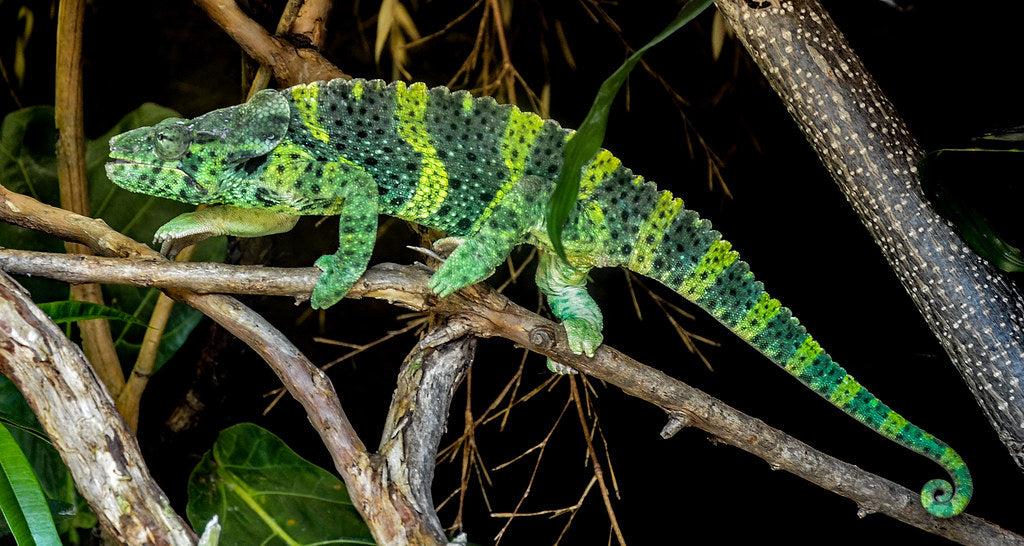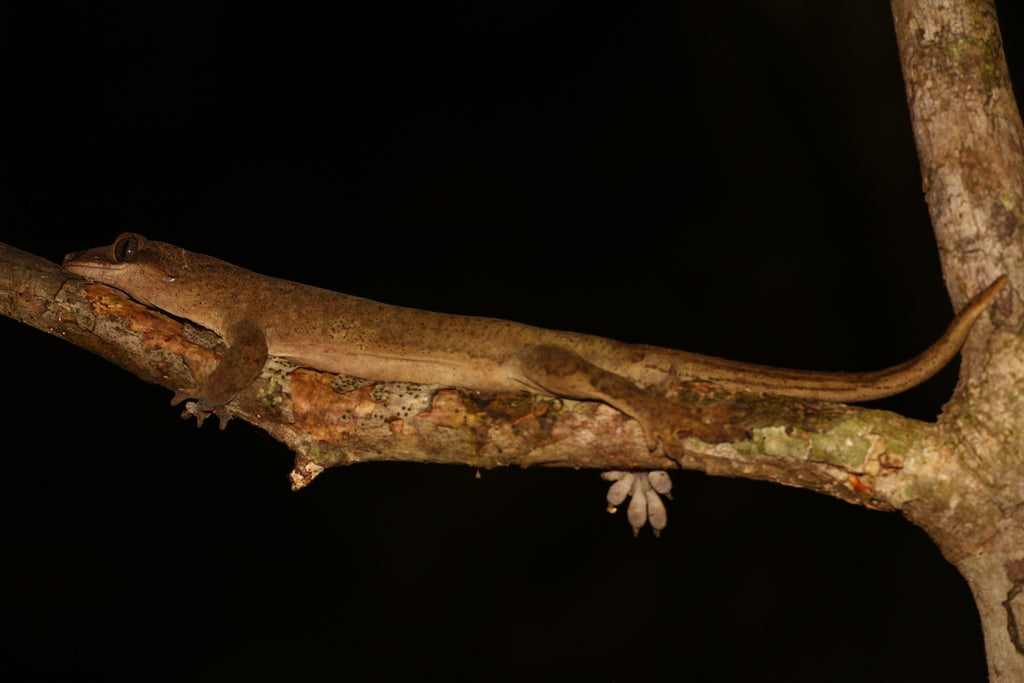Meller’s chameleons (Trioceros melleri) are large, diurnal, arboreal lizards native to the mountains of Tanzania, Mozambique, and Malawi. They prefer areas of high elevation for habitat, with cool air and plenty of rainfall.
Meller’s chameleons grow up to ~24” long, making them one of the largest chameleons in the world. They have a typical chameleon appearance with bulging eyes that rotate independently, a prehensile tail, zygodactylous feet, and a long tongue. Distinguishing features include a scalloped keel along the spine, single horn on the nose, and bright yellow and green coloring (although this shifts with their mood).
Most Meller’s chameleons are wild-caught imports, which means that they start their lives in captivity at a disadvantage. Captive-bred specimens are more expensive, but much more likely to be healthy. With appropriate husbandry, a Meller’s chameleon can live up to 14 years.
How much space do Meller’s chameleons need?
A single Meller’s chameleon should be housed in no smaller than a 2’L x 2’W x 4’H enclosure as juveniles, but they should be upgraded to 5’ x 3’ x 5’ or larger as they grow out of babyhood. Larger is strongly recommended for this species, as they are quite active.
Despite common claims that chameleons “require” a full-mesh enclosure, special care needs to be taken with Meller’s chameleons because they are too large and heavy for the usual mesh screen that is used for building these enclosures. Instead, use plastic-coated ¼” wire mesh.
Cohabitation (keeping multiple chameleons in the same enclosure) is not recommended.
Do Meller’s chameleons need UVB?
Yes!
UVB lighting is required for Meller’s chameleons to stay healthy. Aside from helping provide a day/night cycle and providing an infinite supply of vitamin D, UVB is also good for the lizard’s overall health. Here are the best UVB bulbs for Meller’s chameleons, and how far the lamp should be mounted above the chameleon’s back when it’s standing on the basking branch:
- Arcadia T5 HO 6% — 6”
- Zoo Med T5 HO Reptisun 5.0 — 6”
- Arcadia T5 HO 12% — 12”
- Zoo Med T5 HO Reptisun 10.0 — 12”
The UVB bulb should be housed in a reflective T5 HO fixture like Arcadia or Vivarium Electronics, and roughly half the length of the enclosure. Make sure that the fixture your UVB bulb is housed in does not have a clear plastic bulb cover, as plastic and glass block UVB.
Meller’s chameleons are diurnal, which means that they are most active during the day. This means that it’s beneficial to provide an additional daylight-spectrum lamp to make sure the enclosure is brightly illuminated. Extra light is also essential for allowing live plants to thrive. The Arcadia LED Bar or similar is a good choice for this, roughly the same length as the enclosure itself.
Provide 13 hours of light per day during summer and 11 hours per day during winter. This helps replicate the natural cycle of daylight in the wild.
What basking temperatures do Meller’s chameleons need?
Meller’s chameleons need a basking area temperature around 85°F and a general air temperature of 70-75°F. Heating should be turned off at night, and a nightly temperature drop of at least 10°F is beneficial. Temperatures should be measured with digital probe thermometers, with probes placed on the basking spot and the floor on the cool side.
The basking surface itself should be a sturdy wood branch or vine placed near the top per the specifications listed previously.
Provide heat for your chameleon with a halogen heat lamp placed on one side of the enclosure. For best results, elevate the lamp above the top of the enclosure with the Exo Terra Light Bracket or by hanging it from the ceiling with a lamp chain. The lamp should be at least 12” above the basking branch to prevent burns. Do not use ceramic heat emitters (CHEs), heat mats, red bulbs, or blue bulbs, as these are not as effective.
What humidity levels do Meller’s chameleons need?
Meller’s chameleons do best with low humidity (~50%) during the day and high humidity (90-100%) at night. Meller’s chameleons are slow drinkers and need a lot of water, so you’re going to need an automatic misting system with a large reservoir. This should be run 3x/day (morning, early afternoon, and night) for 15-20 minutes per session. Then run a humidifier over the course of the night, using a hydrostat to maintain optimal humidity.
Reptile humidifiers and foggers should only be used with distilled water and require frequent disinfecting to keep your reptile from getting sick.
Humidity should be measured with a digital probe hygrometer with the probe in the middle of the terrarium. Humidity levels that are consistently too high or low will make your chameleon sick!
What substrate is good for Meller’s chameleons?
Because Meller’s chameleons are strictly arboreal, and because of all the water that goes through their enclosures every day, it’s best not to use a substrate with this species. Instead, use a solid bottom with a drain into a large bucket. This will require some DIY, but is well worth it in the end.
What décor can you use in a Meller’s chameleon terrarium?
A bare, minimalistic enclosure leads to a stressed chameleon — and a stressed chameleon is a chameleon that quickly gets sick. In order to create a functional setup for your Meller’s chameleon, you will need plenty of thin branches, vines, and plants (preferably live, as this really helps with the humidity issue). Arrange the foliage to create hiding places for the chameleon to use as needed, with an open area under the heat lamp.
What do Meller’s chameleons eat?
Meller’s chameleons are strictly insectivorous, which means that they need to eat a variety of insects to get the nutrition that they need. How much they need to eat varies depending on age:
- Juveniles — As much as they can eat
- Adults — 1-2 feeders/day
Feeder insect options for Meller’s chameleons: crickets, grasshoppers, discoid roaches, dubia roaches, Madagascar hissing roaches, black soldier flies, hornworms, hornworm moths, silkworms, superworms, darkling beetles, mantids
Remember, variety is key to great nutrition!
Supplements
You will also need calcium and vitamin supplements to prevent your chameleon from developing a deficiency. Follow this schedule for supplementing a Meller’s chameleon:
- Every feeding: Arcadia EarthPro A
- Once per month: Repashy Calcium Plus LoD
Occasionally skipping a dusting is unlikely to be harmful. In fact, Meller’s chameleons are sensitive to oversupplementation, so it’s likely to help keep your cham healthier. However, it’s important to make sure that all feeders are well hydrated and gutloaded!
Do Meller’s chameleons like to be handled?
Truthfully, few reptiles actually “like” to be handled. When it comes to Meller’s chameleons, they’re generally “hands-off” pets that are better to admire than to handle regularly, although there are some exceptions. The key to building a trusting relationship with your pet is to provide as many positive interactions as possible. Offering food from feeding tweezers is a good way to bond.
*This care sheet contains only very basic information. Although it’s a good introduction, please do further research with high-quality sources to obtain additional information on caring for this species.
"Virginia ZOO in Norfolk - Meller's Chameleon (Trioceros Melleri)" by TDelCoro is licensed under CC BY-SA 2.0



Leave a comment
This site is protected by hCaptcha and the hCaptcha Privacy Policy and Terms of Service apply.